Bourke Ulick J. Aryan Origin of the Gaelic Race and Language
Подождите немного. Документ загружается.

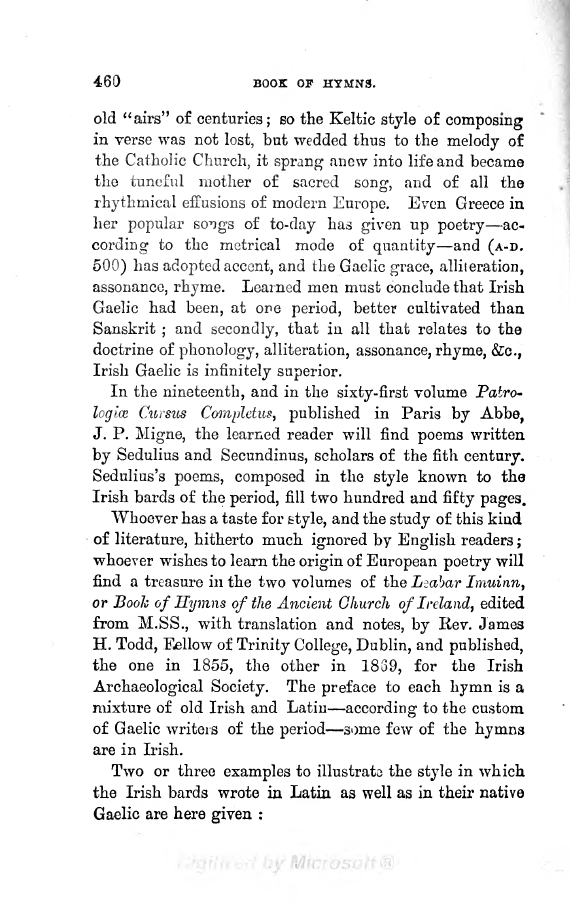
460
BOOK
OF
HYMNS.
old
"airs"
of
centuries
;
so
the
Keltic
style
of
composing
in
verse was not
lost,
but
wedded
thus
to the
melody
of
the Catholic
Church,
it
sprang
anew
into
life and
became
the tuneful
mother
of
sacred
song,
and of all
the
rhythmical
effusions
of
modern
Europe.
Even
Greece
in
her
popular
so^gs
of
to-day
has
given up poetry
ac-
cording
to the
metrical
mode
of
quantity
and
(A-D.
500)
has
adopted
accent,
and the
Gaelic
grace,
alliteration,
assonance,
rhyme.
Learned men
must
conclude that
Irish
Gaelic
had
been,
at
ore
period,
better cultivated
than
Sanskrit
;
and
secondly,
that in
all that relates to
the
doctrine of
phonology,
alliteration, assonance,
rhyme,
&c.,
Irish
Gaelic
is
infinitely
superior.
In
the
nineteenth,
and
in
the
sixty-first
volume
Pairo-
logice
Cursus
Completus,
published
in
Paris
by
Abbe,
J.
P.
Migne,
the
learned reader will
find
poems
written
by
Sedulius and
Secundinus,
scholars of
the
fith
century.
Sedulius's
poems,
composed
in the
style
known to the
Irish bards of
the
period,
fill
two hundred and
fifty pages.
Whoever
has a
taste
for
etyle,
and the
study
of this
kind
of
literature,
hitherto
much
ignored
by
English
readers
;
whoever
wishes to learn the
origin
of
European
poetry
will
find a
treasure
in
the
two volumes
of
the L^abar
Imuinn,
or Book
of Hymns
of
the Ancient Church
of
Ireland,
edited
from
M.SS.,
with
translation and
notes,
by
Rev.
James
H.
Todd,
Eellow
of
Trinity College,
Dublin,
and
published,
the one in
1855,
the other in
1839,
for the
Irish
Archaeological
Society.
The
preface
to each
hymn
is a
mixture of
old Irish and
Latin
according
to the
custom
of
Gaelic
writers
of the
period
some
few
of the
hymns
are
in
Irish.
Two or
three
examples
to
illustrate
the
style
in
which
the Irish bards wrote
in Latin as
well
as
in their native
Gaelic
are here
given
:
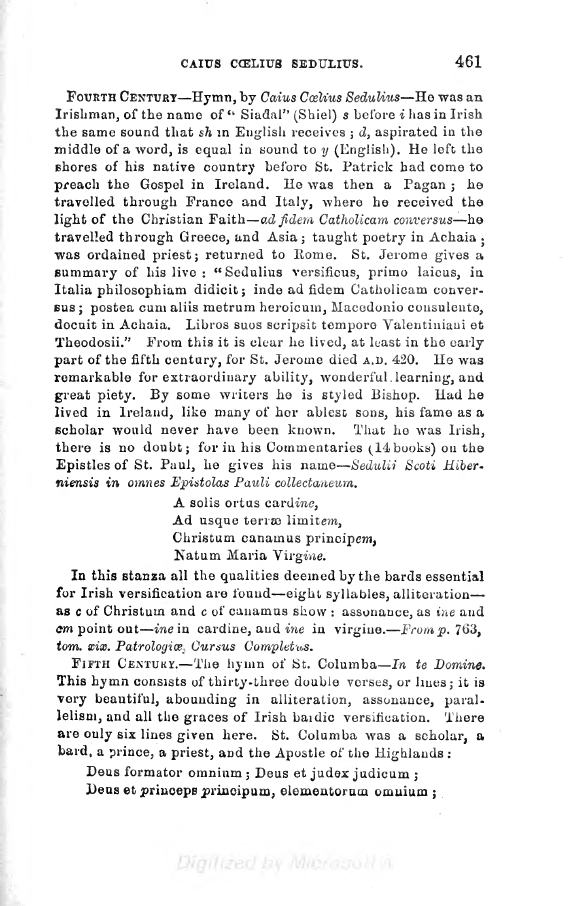
CAIUS CCELIU8 SEDULIUS.
461
FOURTH CENTURY
Hymn,
by
Caius Ocellus Sedulius
He was an
Irishman,
of the
name of
"
Siadal"
(Shiel)
s
before i
has in Irish
the same sound that
sh
in
English
receives
;
d,
aspirated
in
the
middle of
a
word,
is
equal
in
sound to
y
(English).
He
left
the
shores
of his
native
country
before
St.
Patrick
had
come
to
preach
the
Gospel
in Ireland. He
was then a
Pagan
;
he
travelled
through
France
and
Italy,
where he received
the
light
of the
Christian
Faith
adfidem
Catholicam conversus
he
travelled
through
Greece,
und
Asia;
taught
poetry
in Achaia
.
was
ordained
priest;
returned
to
Rome. St.
Jerome
gives
a
summary
of his live
:
"
Sedulius
versificus,
primo laicus,
in.
Italia
philosophiam
didicit;
inde
ad
fidem
Catholicam
conver-
sus
;
postea
cum aliis metrum
heroicum,
Macedonio
consulente,
docuit
in
Achaia.
Libros
suos
scripsit tempore
Valentiniaui
et
Theodosii."
From this
it is
clear he
lived,
at
least
in
the
early
part
of the fifth
century,
for
St.
Jerome
died
A.D.
420.
He
was
remarkable
for
extraordinary
ability,
wonderful.
learning,
and
great
piety. By
some writers he
is
styled Bishop.
Had
he
lived
in
Ireland,
like
many
of her ablest
sons,
his fame as a
scholar would
never
have been
known. That he was
Irish,
there
is
no
doubt;
for in
his
Commentaries
(14
books)
on the
Epistles
of St.
Paul,
he
gives
his
name
Sedulii Scoti Hiber-
niensis in
omnes
Epistolas
Pauli
collectaneum.
A
solis
ortus
cardme,
Ad
usque
terrse
limitem,
Christum canamus
principem,
Natum
Maria
Virgine.
In this stanza all
the
qualities
deemed
by
the
bards
essential
for Irish
versification
are found
eight
syllables,
alliteration
as
c
of
Christum
and c
of
caiiamus
show
:
assonance,
as
ine and
cm
point
out
ine
in
cardine,
and
ine in
virgiue.
From
p.
763,
torn. scix.
Patrologice^
Curtus
Completes.
FJFTH
CENTURY. The
hymn
of St.
Columba
In
te
Domine.
This
hymn
consists
of
thirty-three
double
verses,
or
lines;
it
ia
very
beautiful,
abounding
in
alliteration,
assonance,
paral-
lelism,
and all
the
graces
of
Irish bardic
versification. There
are
only
six
lines
given
here.
St. Columba was a
scholar,
a
bard,
a
prince,
a
priest,
and
the
Apostle
of the
Highlands
:
Deus
formator
omnium
;
Deus
et
judex
judicum
;
Deos
eb
jpriuoeps
jpriuoipum,
elementorum
omnium
;

462
COLUMBA'S
HYMNS.
Deus
Zargus,
Zonganimid ;
Deus Doctor
docibilis
;
Deus
qui
facit
omnia,
nova
cuncta
et
vetera
:
Christus
redemptor gentium
;
Christus amator
virginum
;
Christus
fous
sapientium ;
Christus
fides
credentium.
The
words
jndex, judicum,
2>rinceps, ^rincipum,
and
Zargns
longaminis,
Deas, doctor,
docibilis,
show
that
alliteration,
is
not
overlooked.
Omnium,
judicwn,
principwm,
are
instances
of
assonance
(us,
and
or,
and
is,
final
syllables
in
first
part, De-us,
largws,
longanirms,
makes
a
parallelism
with
MS,
and
o^,
and
is,
in
the
second
part.)
So, too,
the final
syllables
of
Christtts,
redemtor
gentiitm,
with those
of
Christits
amator,
virginwm.
Each line
expresses
a
proposition.
In each
the
sense
is
complete.
Again
Read these four lines
from
another
hymn,
Noli
Pater,
by
St.
Columba, p. 262,
vol.
ii.,
Book
of
Hymns,
by
Dr.
Todd:
Te
timemns
ierribiZem,
Nullum credentes
simiZam;
Te cuncta
canunt
carimna
Angelorum
per
agmina.
Alliteration
Tin
te,
in
iimerous,
terribilem.
in
cuncta,
canunt,
and
carmina.
Assonance,
")
Bilem,
of terribilem
;
milvm,
of
similem
;
mina,
Rhyme,
/
o
f
carmina
and
agmina.
These
few
instances
must suffice.
The writer
has
in
his
possession
some
twenty
-five
hjmna
in Irish
Gaelic
M.SS.
attributed to
St. Columba.

(463)
CHAPTER
XVI.
A thousand
volumes of
unpublished
Irish
Gaelic
still
extant.
Testimonies.
Composed
chiefly
in
and
adorned
with
graces
of Irish
verse.
The
amazing
literary
labor of
the Christian and
pre-Christian
Irish.
Supe-
riority
of
Irish
Gaelic over
Sanscrit,
especially
in
the
beauties
of
versification. Historic
suggestiveness
of
Gaelic
words.
European
Keltic
area.
Names of
persons,
places,
things.
Historical doubts
cleared
up.
Rome
called
from the
color
of
the
Tiber's
waters.
Romulus from Rome. How
the Sabines
and
Romans
were
amalgamated. Meaning
of
Quirites.
Brennus.
The
Etruscan
Lucumo.
The
Sabines were
Gaels.-
Romans
composed
of four races. The
Sabines
lost
their
Gaelic,
but
gave
to
Rome their
phonesis,
and
many
of
their
civil
and
religious
customs. Astrono-
mical Gaelic
terms were never
borrowed from Rome
for
at
the
time,
in
the
early pagan
period,
Ireland
had
no connexion
with
Pagan
Rome.
Adolphe
Pictet'a
proof
of the
Aryan origin
of the
Irish
Gaelic
and of
the Irish Eace. Frazer's
Magazine.
Conclusion.
Summary
of
points proved.
Shall the
Gaelic
language
die?
A
thousand
volumes of
unpublished
Irish
Gaelic
are
still
extant.
The
highest
testimony
that can be
pre-
sented
on
the
subject
of
Irish
manuscripts,
the
written
assurance of
Professor
O'Loony,
M.R.I.
A.,
of
the
Catholic
University,
Dublin,
and that
of
Rev.
Professor
O'Mahony,
M.R.I.A.
of
Trinity
College,
Dublin
is offered as
suffi-
cient
motive to
convince
the reader
that
the
statement
is
only
the
expression
of
a
fact.
The
learned
reader
may
well
be
surprised,
that
after
all the
drowning
and
burn-
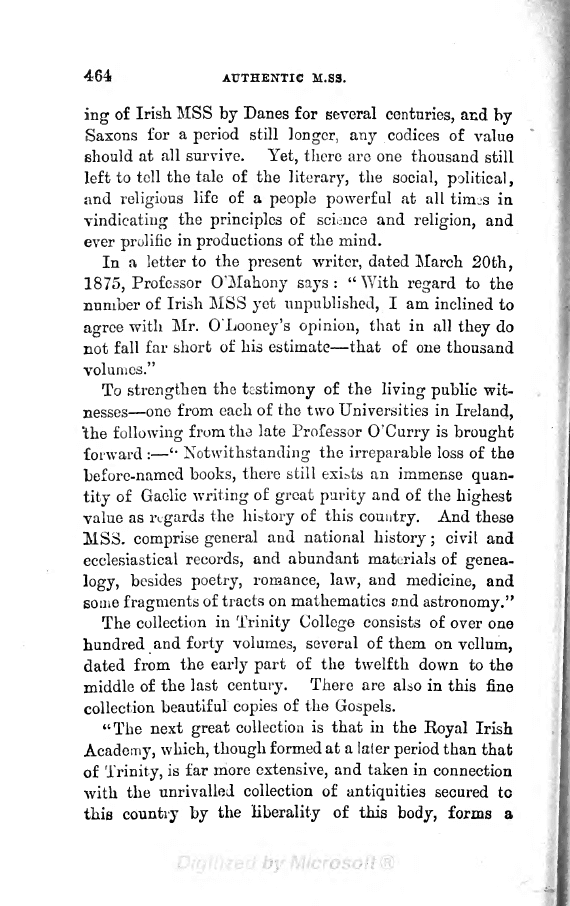
464
AUTHENTIC
M.S3.
ing
of
Irish
MSS
by
Danes for
several
centuries,
and
by
Saxons
for
a
period
still
longer,
any
codices
of
value
should
at
all
survive.
Yet,
there are one
thousand
still
left
to tell
the
tale of
the
literary,
the
social,
political,
and
religious
life of
a
people powerful
at all
tim-s in.
vindicating
the
principles
of science
and
religion,
and
ever
prolific
in
productions
of the
mind.
In
a
letter
to
the
present
writer,
dated
March
20th,
1875,
Professor
O'Mahony
says
:
"
With
regard
to
the
number
of
Irish MSS
yet unpublished,
I
am
inclined
to
agree
with
Mr.
Looney's
opinion,
that in
all
they
do
not
fall
far short
of
his
estimate that of
one
thousand
volumes."
To
strengthen
the
testimony
of the
living public
wit-
nesses
one
from each
of the
two
Universities
in
Ireland,
1the
following
from
the
late
Professor
O'Curry
is
brought
forward
:
''
Notwithstanding
the
irreparable
loss of
the
before-named
books,
there still exists an
immense
quan-
tity
of Gaelic
writing
of
great purity
and
of
the
highest
value
as
regards
the
history
of
this
country.
And
these
MSS.
comprise
general
and
national
history
;
civil
and
ecclesiastical
records,
and abundant
materials of
genea-
logy,
besides
poetry,
romance, law,
and
medicine,
and
some
fragments
of tracts on
mathematics and
astronomy."
The
collection
in
Trinity
College
consists
of
over
one
hundred
and
forty
volumes,
several of them
on
vellum,
dated
from
the
early part
of the
twelfth
down to
the
middle
of
the
last
century.
There are
also in
this
fine
collection
beautiful
copies
of the
Gospels.
"The
next
great
cullection
is that in
the
Royal
Irish
Academy,
which,
though
formed at
a
later
period
than
that
of
Trinity,
is
far
more
extensive,
and
taken in
connection
with
the
unrivalled
collection
of
antiquities
secured
to
this
country
by
the
liberality
of
this
body,
forms a
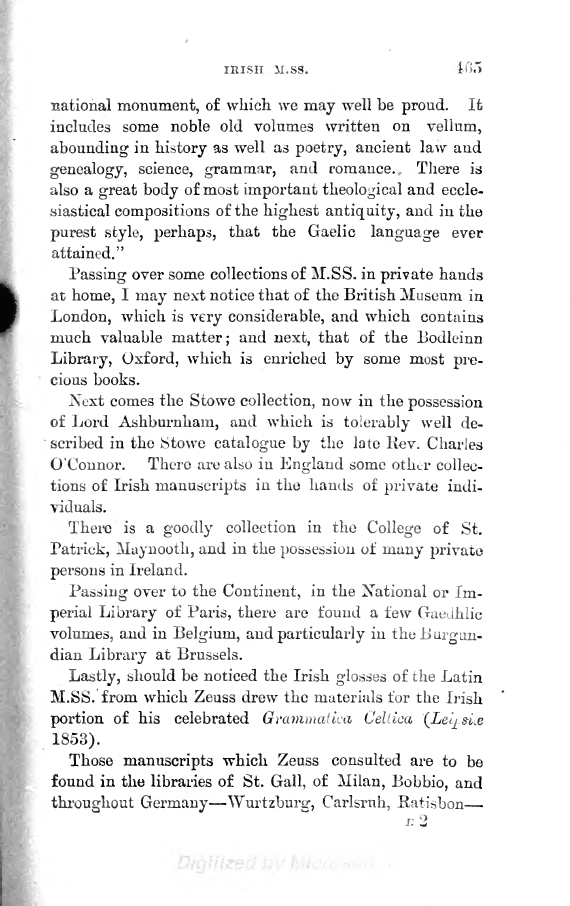
IRISH
M.SS.
465
national
monument,
of
which
we
may
well be
proud.
It
includes
some
noble
old
volumes written
on
vellum,
abounding
in
history
as well as
poetry,
ancient law and
genealogy,
science,
grammar,
and
romance..
There
is
also
a
great
body
of most
important
theological
and
eccle-
siastical
compositions
of the
highest antiquity,
and in
the
purest style, perhaps,
that the
Gaelic
language
ever
attained."
Passing
over some collections
of
M.SS.
in
private
hands
at
home,
I
may
next
notice
that of the
British
Museum
in
London,
which is
very
considerable,
and which
contains
much
valuable
matter;
and
next,
that of the
Bodleinn
Library,
Oxford,
which
is enriched
by
some
most
pre-
cious books.
Next
comes
the
Stowe
collection,
now
in
the
possession
of Lord
Ashburnham,
and which is
tolerably
well
de-
scribed
in the Stowe
catalogue
by
the
late
Rev.
Charles
O'Connor.
There are
also in
England
some
other
collec-
tions of Irish
manuscripts
in
the
hands
of
private
indi-
viduals.
There is
a
goodly
collection
in
the
College
of
St.
Patrick,
Maynooth,
and
in the
possession
of
many private
persons
in Ireland.
Passing
over
to the
Continent,
in
the
National
or
Im-
perial
Library
of
Paris,
there are found a
few
Gaedhlic
volumes,
and in
Belgium,
and
particularly
in
the
Burgun-
dian
Library
at
Brussels.
Lastly,
should be noticed
the Irish
glosses
of the
Latin
M.SS.
from
which Zeuss drew
the
materials for
the
Irish
portion
of his celebrated Grammatica
Celtica
'(LeLj.aics
1853).
Those
manuscripts
which
Zeuss consulted
are
to
be
found in the
libraries
of
St.
Gall,
of
Milan,
Bobbio,
and
throughout Germany
Wurtzburg,
Carlsruh,
Ratisbon
E2

466
MANUSCRIPTS,
AS
A
RULE,
METRICAL.
and
are
the
glosses
written in
Irish
Gaelic,
sometimes
in
Latin,
on
the
margin,
or
between the
written lines of
the
body
of
the
work :
"
Hiberni
codices vetustas
lingua?
jrionumenta*
servantes
in
copiosis
prsesertim
glossis,
inter-
linearibus
plurimum, saepius
etiani
marginalibus,
in
terra
continente
extant
plures
a
monachis
scripti
Hibernis,
jam
a sseculo sexto
per
Europam
continentem
ad
propa-
gandam
fidem
Christianam
dispersis."
Zeuss.
For
example,
at
St.
Gall,
Switzerland,
he
found
a ma-
nuscript copy
of
Priscian's famous
work on
grammar.
This
codex
had
been
manifestly
a
copy
made
use of
by
a
professor
in
Ireland,
or
from
Ireland,
for
the
margin
of
each
page
of fourteen
books of the
codex is
laden with
comments
in the
Irish
language
:
magnam
glossarum
molem
prebens,
quibus
refertus est.
The
names
of
those scholars who wrote the
glosses
are
given
in the
work
;
and
Zeuss's own view on
the
authen-
ticity
and value of these
M.SS.
are
seen
in
the
preface
to
the Grammatical,
Celiica.
But
that
special
view
of
the
subject
cannot here be allowed
more
than
a
passing
allusion.
All
the
early
ancient
Irish
writings
are,
speaking
generally,
composed
in
bardic
verse. "Hoc solum
anna-
Hum
genus
habebant
quod
in
epicis
carminibus et
in
narrationibus
metrice
compositis
consistet."
Henry
Leo.
Preface
to his
commentary
on St. Fiacc's
hymn
in
praise
of
St.
Patrick.
Halis
Saxonum,
1845.
The
difficulty
of
writing
in
that
style
of
verse
is
already
known
to
any
one who has
read
the
chapter
just
brought
to
a
close;
each verse should consist
of seven
syllables,
at
times
of
eight
;
each
line
should
express
a
judgment,
and
form
complete
sense alliteration
and
assonance,
and
consequently
rhyme,
at times should
grace
the verse
;
and
parallelism
of
terms
and
thoughts
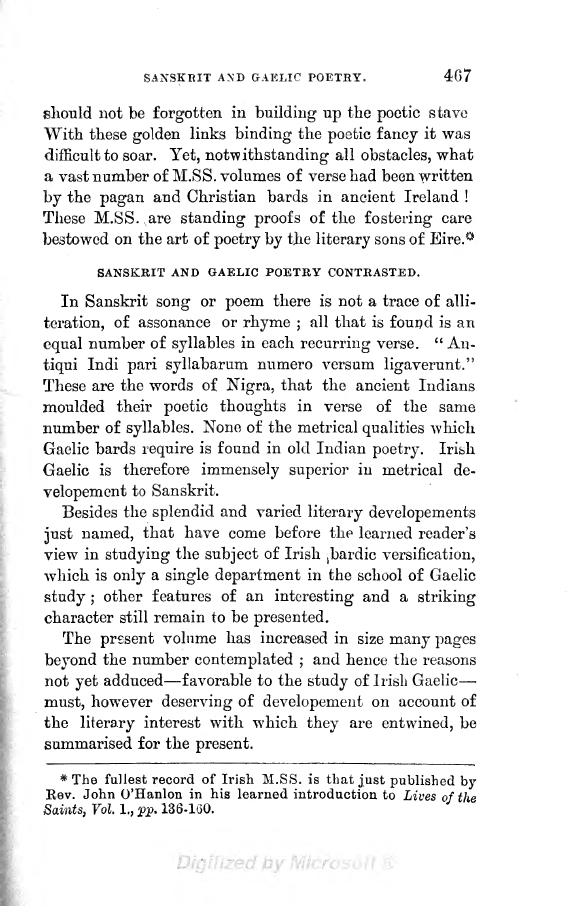
SANSKRIT
AND GAELIC POETRY.
467
should
not be
forgotten
in
building up
the
poetic
stave
With these
golden
links
binding
the
poetic fancy
it was
difficult to
soar.
Yet,
notwithstanding
all
obstacles,
what
a
vast
number
of M.SS. volumes
of
verse had been
written
by
the
pagan
and
Christian
bards
in
ancient
Ireland !
These
M.SS.
are
standing proofs
of
the
fostering
care
bestowed
on
the art of
poetry
by
the
literary
sons of
Eire.*
SANSKRIT
AND GAELIC
POETRY
CONTRASTED.
In
Sanskrit
song
or
poem
there is
not
a trace of
alli-
teration,
of
assonance
or
rhyme
;
all
that is
fouijd
is an
equal
number
of
syllables
in
each
recurring
verse.
"
An-
tiqui
Indi
pari
syllabarum
numero
versum
ligaverunt."
These
are
the words
of
Nigra,
that
the
ancient
Indians
moulded
their
poetic thoughts
in
verse
of the
same
number
of
syllables.
None of the
metrical
qualities
which
Gaelic
bards
require
is found
in
old Indian
poetry.
Irish
Gaelic
is
therefore
immensely
superior
in
metrical
de-
velopement
to Sanskrit.
Besides
the
splendid
and
varied
literary developements
just
named,
that
have come
before
the
learned
reader's
view
in
studying
the
subject
of
Irish
t
bardic
versification,
which
is
only
a
single department
in
the
school
of Gaelic
study
;
other
features of an
interesting
and a
striking
character
still
remain to be
presented.
The
present
volume
has increased in
size
many pages
beyond
the number
contemplated
;
and
hence
the reasons
not
yet
adduced favorable to the
study
of Irish
Gaelic-
must,
however
deserving
of
developement
on account
of
the
literary
interest with
which
they
are
entwined,
be
summarised
for the
present.
*
The
fullest record
of
Irish M.SS.
is
that
just
published
by
Rev.
John O'Hanlon
in
his
learned
introduction
to
Lives
of
the
Saints,
Vol.
1., pp.
136-160.

468
KELTIC
AREA.
Not
only
the
Irish Brehon
Law,
and
the
Gaelic
poems
in
matter as
well as
in
form,
but the
very
terms
of
the
Irish Gaelic
language
are full of rich
suggestrveness
of
historic interest.
EUROPEAN KELTIC AREA.
The
topography
of
Europe
is a
history
in
Gaelic
of
the
migrations
of the Keltic
race.
From
the classical
researches of
Latham,
one
sees
at a
glance
the
wide
range
of
territory
which
a
Gaelic
speak-
ing
race
at
one
time
occupied. They
spread
over Helvetia
(modern
Savoy
and
Switzerland),
Rhcetia,
or the
Tyrol
;
Styria,
Carinthia,
Illyria,
Dalmatia,
the lower
Danube,
the
Bastarna3,
the
Galetsa,
Wurtemburg,
Bavaria,
Bo-
hemia, Thracia, Macedonia, Grsecia,
Galatia
(in
Asia
Minor), Belgium,
middle
Rhine,
the
Ligurians,
the
Spanish
Peninsula,
Italia,
Gallia,
Britannia, Hibernia,
or
Scotia
Major,
Caledonia or
Scotia
Minor,
the
Isle
of
Man,
and
the
islands
to
the west
and
north.
The
original
Keltic area
is
one
thing,
the
areas
into
which
the
Kelts intruded
themselves
is
another. Ger-
many
is
the
original English
area.
England,
and still
more
America,
are
areas
into
which the
English
have
intruded.
The
Keltic
area,
then,
according
to Dr. Latham
(see
supplementary
chapter
in
new
edition of
Prichard's
Keltic
Nations,
by
Dr.
Latham,
published by
Bernard
Quaritch,
London,
1857,)
extends
over the
foregoing
ter-
ritories
:
NAMES
OF
PERSOXS.
"How
interesting," says
Geddes,
''it
is to know that
the leader
under
whom
the
Gauls
poured
down
upon
Rome
in
890
B.C.,
bore
among
the
Romaus the name
jL,
ctidus,
and
that
this is
still
the
Gaelic name ior
judye
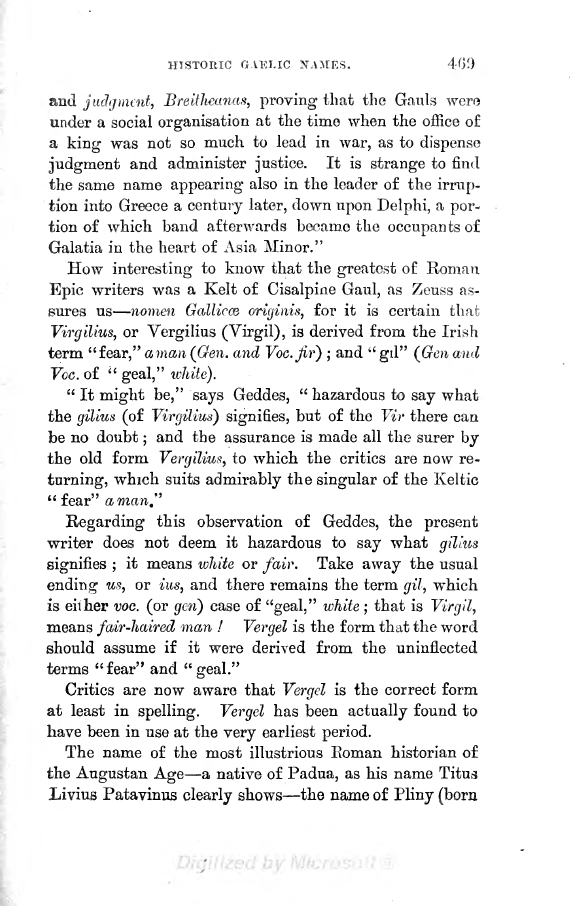
HISTORIC
GAELIC XAMES.
409
and
judgment,
Breitheanas,
proving
that
the
Gauls were
under a
social
organisation
at
the
time when
the
office
of
a
king
was
not
so
much to
lead
in
war,
as to
dispense
judgment
and
administer
justice.
It
is
strange
to find
the same
name
appearing
also in
the leader
of the
irrup-
tion into Greece
a
century
later,
down
upon
Delphi,
a
por-
tion of which
band
afterwards became the
occupants
of
Galatia
in
the
heart
of Asia Minor."
How
interesting
to
know that
the
greatest
of
Roman
Epic
writers was
a
Kelt of
Cisalpine
Gaul,
as
Zeuss as-
sures
us
nortien
Gallicce
oriyinis,
for it
is certain
that
Virgilius,
or
Vergilius
(Yirgil),
is derived
from
the
Irish
term
"fear,"
aman
(Gen.
and
Voc.fir}
;
and
"
gil"
(Gen
and
Foe.
of
"
geal," white).
"
It
might
be,"
says
Geddes,
"
hazardous to
say
what
the
gilius
(of
Virgilius)
signifies,
but
of the
Vir there
can
be
no doubt
;
and the
assurance
is made all the
surer
by
the
old
form
Vergilius,
to which the critics
are now
re-
turning,
which suits
admirably
the
singular
of
the
Keltic
"fear"
aman."
Regarding
this
observation of
Geddes,
the
present
writer
does
not
deem
it
hazardous
to
say
what
gilius
signifies
;
it
means white or
fair.
Take
away
the
usual
ending
us,
or
ius,
and
there remains the term
gil,
which
is either
voc.
(or
gen)
case of
"geal,"
white
;
that
is
Virgil,
means
fair-haired
man !
Vergel
is the form that
the
word
should
assume
if it
were
derived from the uninflected
terms
"fear" and
"geal."
Critics
are now
aware
that
Vergel
is
the correct form
at
least
in
spelling.
Vergel
has been
actually
found to
have
been in
use at
the
very
earliest
period.
The name
of
the
most
illustrious
Eoman historian of
the
Augustan
Age
a
native of
Padua,
as his
name
Titus
Livius Patavinus
clearly
shows
the
name of
Pliny
(born
